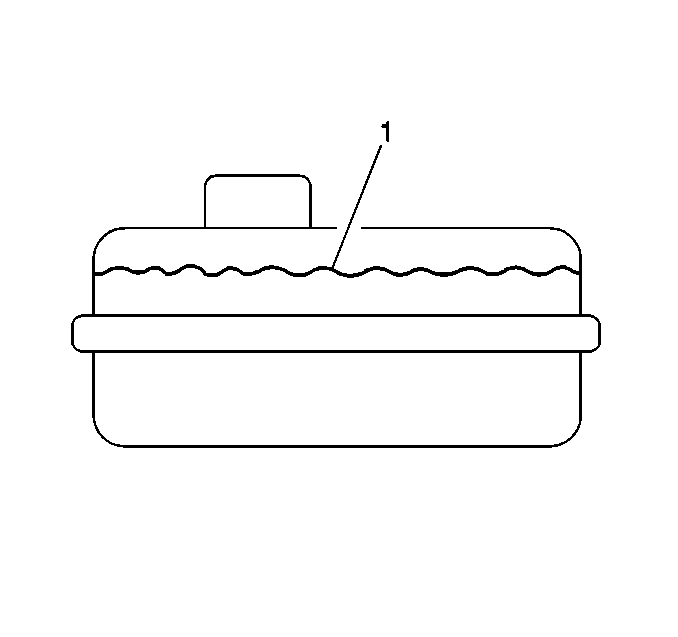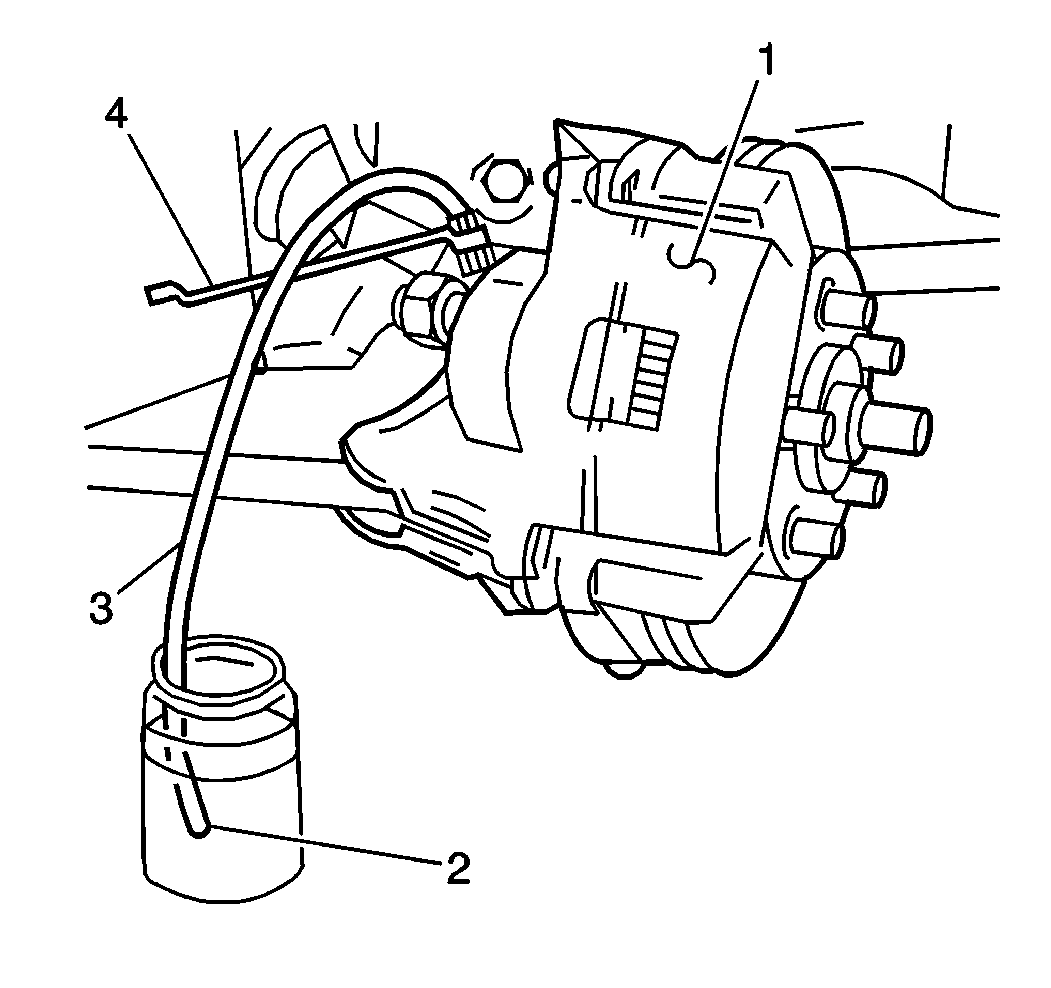Caution: Do not move the vehicle until a firm brake pedal is obtained. Air in
the brake system can cause the loss of brakes with possible personal injury.
Caution: Use only Delco Supreme 11, GM P/N 12377967 (Canadian P/N 992667), or
equivalent DOT 3 brake fluid from a clean, sealed container. Do not
use fluid from an open container that may be contaminated with water.
Improper or contaminated fluid could result in damage to components, or
loss of braking, with possible injury.
Caution: Do not overfill the brake fluid reservoir. Overfilling the brake fluid
reservoir may cause the brake fluid to overflow onto the engine exhaust components
during brake system service. The brake fluid is flammable and
may cause a fire and personal injury if the brake fluid contacts the engine
exhaust system components.
Notice: Brake fluid will damage electrical connections and painted surfaces.
Use shop cloths, suitable containers, and fender covers to prevent brake fluid
from contacting these areas. Always re-seal and wipe off brake fluid containers
to prevent spills.
Notice: If any brake component is repaired or replaced such that air is allowed
to enter the brake system, the entire bleeding procedure must be followed.
Notice: Prior to bleeding the brakes, the front and rear displacement cylinder
pistons must be returned to the topmost position. The preferred method uses
a Scan Tool to perform the rehoming procedure. If a Scan Tool
is not available, the second procedure may be used, but it is extremely important
that the procedure be followed exactly as outlined.
A bleeding operation is necessary in order to remove air
when air is introduced into the hydraulic brake system.
Bleed the hydraulic system at all four brakes if air has been introduced
through a low fluid level or by disconnecting brake pipes at the master cylinder.
If a brake hose or brake pipe is disconnected at one wheel, bleed only that
one wheel caliper. If brake pipes or hoses are disconnected at any fitting
located between the master cylinder and the brakes, then only bleed the brakesystem
served by the disconnected pipe or hose.
Pressure Flushing
Tools Required
| • | J 29532 Diaphragm
Type Brake Bleeder |
| • | J 35589 Compact
Brake Bleeder Adapter |
Important:
| • | If evidence of contamination is present in the vehicle's brake
fluid, flush the entire brake system following one of the following procedures. |
| • | Flush the system under the following conditions: |
| - | If there is any doubt about the condition of the fluid in the
system |
| - | If the fluid that is used contains the slightest trace of mineral
oil (engine oil, transmission fluid, etc.) |
| • | After flushing the entire brake system, replace all rubber components. |
| • | Replace the following components. Refer to the appropriate replacement
procedures. |
| - | The brake hose assemblies |
| - | The master cylinder rubber parts |
| - | The brake caliper and wheel cylinder boots and seals |
| - | The proportioning valve |
| • | After replacing all rubber components, re-flush the entire brake
system by performing one of the following procedures. |
Notice: Pressure Bleeding equipment can be used to perform the flush procedure.
The pressure bleeding equipment used for flushing must be of the diaphragm
type. It must a have a rubber diaphragm between the air supply and the brake
fluid to prevent air, moisture, and other contaminants from entering the hydraulic
system.

- Clean the brake fluid
reservoir cover and the surrounding area.
- Remove the brake fluid reservoir cover.
Caution: Brake fluid may irritate eyes and skin. In case of contact, take the
following actions:
| • | Eye contact--rinse thoroughly with water. |
| • | Skin contact--wash with soap and water. |
| • | If ingested--consult a physician immediately. |
Notice: Brake fluid will damage electrical connections and painted surfaces.
Use shop cloths, suitable containers, and fender covers to prevent brake fluid
from contacting these areas. Always re-seal and wipe off brake fluid containers
to prevent spills.
- Remove any remaining brake fluid in the reservoir.
- Refill the brake fluid reservoi (1). Use Delco Supreme No. II
Hydraulic Brake Fluid (GM P/N 12377967) or equivalent DOT-3 motor vehicle
brake fluid.

- Replace all the rubber
components listed under the flushing procedure. Refer to the appropriate On-Vehicle
Service section.
- Repeat the flushing procedure.
- Inspect the brake fluid level in the reservoir (1). Fill
the reservoir to the correct level if necessary.
- Install the brake fluid reservoir cap.
- Bleed the entire brake hydraulic system. Refer to
Hydraulic Brake System Bleeding
.
Manual Flushing
Caution: Brake fluid may irritate eyes and skin. In case of contact, take the
following actions:
| • | Eye contact--rinse thoroughly with water. |
| • | Skin contact--wash with soap and water. |
| • | If ingested--consult a physician immediately. |
Notice: Brake fluid will damage electrical connections and painted surfaces.
Use shop cloths, suitable containers, and fender covers to prevent brake fluid
from contacting these areas. Always re-seal and wipe off brake fluid containers
to prevent spills.

- Remove the battery tray.
Refer to
Battery Tray Replacement
in
Body Front End.
- Clean the brake fluid reservoir cover and the surrounding area.
- Remove the brake fluid reservoir cover.
- Remove any remaining brake fluid in the brake fluid reservoir.
- Refill the brake fluid reservoir (1). Use Delco Supreme No. II
Hydraulic Brake Fluid (GM P/N 12377967) or equivalent DOT-3 motor vehicle
brake fluid.
- Install the brake fluid reservoir cover.

Notice: Use the correct fastener in the correct location. Replacement fasteners
must be the correct part number for that application. Fasteners requiring
replacement or fasteners requiring the use of thread locking compound or sealant
are identified in the service procedure. Do not use paints, lubricants, or
corrosion inhibitors on fasteners or fastener joint surfaces unless specified.
These coatings affect fastener torque and joint clamping force and may damage
the fastener. Use the correct tightening sequence and specifications when
installing fasteners in order to avoid damage to parts and systems.
- Use the following
procedure in order to flush the brake modulator:
| 7.1. | Attach the bleeder hose to the rearward bleeder valve. |
| 7.2. | Submerge the opposite hose end in a clean container partially
filled with clean brake fluid. |
| 7.3. | Slowly open the rearward bleeder valve. |
| 7.4. | Depress the brake pedal and hold the pedal until the fluid begins
to flow. |
| 7.5. | Close the valve and release the brake pedal. Repeat the above
steps until clean brake fluid flows or at least 118 ml (4 oz)
of fluid accumulates. |
| 7.6. | Repeat the procedure for the forward bleeder valve until clean
brake fluid flows or at least 118 ml (4 oz) of fluid
accumulates. |
Tighten
Tighten the ABS brake modulator bleeder valves to 9 N·m
(80 lb in).
- Inspect the brake fluid level and add brake fluid if necessary.
- Raise the vehicle. Refer to
Lifting and Jacking the Vehicle
in General Information.

- Flush the brake system
to the wheel brakes in the following sequence.
- Use the following procedure in order to flush the brake system
to the wheels:
| 11.1. | Attach the bleeder hose (3) to the bleeder valve. |
| 11.2. | Submerge the opposite hose end in a clean container partially (2)
filled with clean brake fluid. |
| 11.3. | Slowly open the bleeder valve. |
| 11.4. | Depress the brake pedal and hold the pedal until the fluid begins
to flow. |
| 11.5. | Close the bleeder valve and release the brake pedal. Repeat the
above steps until clean brake fluid flows or at least 235 ml (8 oz)
of fluid accumulates. |
| 11.6. | Inspect the brake fluid level and add brake fluid if necessary.
Do not let the brake fluid reservoir go empty. |
Tighten
| • | Tighten the front caliper bleeder valves to 13 N·m
(115 lb in). |
| • | Tighten rear caliper bleeder valves to 7 N·m (62 lb in). |
| • | Tighten the rear wheel cylinder bleeder valves to 7 N·m
(62 lb in). |
- Lower the vehicle.
- Replace all of the following rubber components:
| • | The brake hose assemblies |
| • | The master cylinder rubber parts |
| • | The brake caliper and wheel cylinder boots and seals |
| • | The proportioning valve |
- Repeat the manual flushing procedure.
- Inspect the brake fluid level in the reservoir. Fill the reservoir
to the correct level if necessary.
- Replace the brake fluid reservoir cap.
- Bleed the entire brake hydraulic system. Refer to
Hydraulic Brake System Bleeding
.
- Install the battery tray. Refer to
Battery Tray Replacement
in Body Front End.





